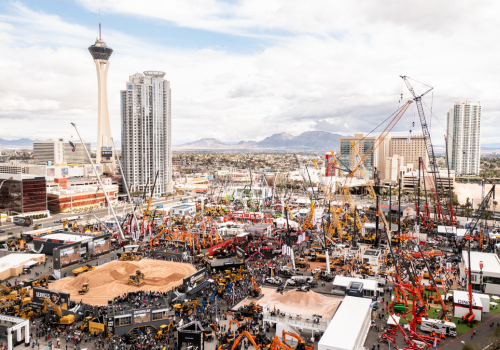Workers paving roads in the summer months can get pretty hot, but Geoffrey Grant says his team has a variety of ways to stay safe.
“We take advantage of shade whenever possible, and we try not to overexert ourselves by working at a moderate pace,” says Grant, paving supervisor for All States Construction based in Killingly, Conn.
Everyone takes frequent water breaks and there are also plenty of electrolytes available, he says. Eating well with plenty of fruits is very important, too.
“Some of us wear long sleeves to cover our skin and also wide brim hats to keep our face covered,” Grant says.
Avoiding heat on the job site
It can be difficult to avoid heat when working outside, but employers can enact measures to keep their workers from heat stress illness by following the standard hierarchy of controls – starting with the most effective ways, says Monica Rakoczy, owner of EnterTraining Solutions LLC based in Lancaster, Pa.
“The very first thing that you try to do is eliminate the hazard, though heat elimination is obviously not something that we can normally do,” Rakoczy says. “So, we would go to step No. 2, which is utilizing engineering controls. These are changing parts of the environment around you to keep workers safe.”
Employers should find ways to provide shade, either by setting up some cooling tents or having designated areas that workers can take breaks, she says. Portable air conditioning units or fans can keep those areas even cooler for workers.
update cooling practices & procedures
Moving down the hierarchy controls, the next thing that employers can do to keep workers safe is employ administrative controls – workplace practices and procedures, Rakoczy says. Many employers change the working hours of a project so that high effort activities can be done during the cooler parts of the day – or even at night. Another tactic is rotating job duties among workers.
“For example, rather than having one person maybe who has to wear a Tyvek suit that is super hot, you can rotate the job so that everybody's getting a little bit of exposure, but nobody's being exposed to it all day long,” she says.
Employees should also take mandatory breaks to rest and drink water, preferably in the shade, Rakoczy says. Since workers lose a lot of salt when they're sweating in the hot sun, it’s important to provide electrolyte supplements, like drink mixes, premixed drinks or even electrolyte pops like ice pops.
Revamped Cooling PPE
As summer temperatures rise, so does the risk of heat-related illness on construction sites. But with the right strategies, crews can stay safe and productive—even in triple-digit heat.
While personal protection equipment may be the least effective way to keep workers safe because at that point they are exposed to the hazard, there are ways to improve the effectiveness of PPE, she says.
“For example, flame resistant closing traditionally has been very bulky, very heat intensive,” Rakoczy says “But manufacturers are starting to learn from that and they are now making them out of lighter weight material and putting vents into them, while still keeping the FR capabilities.”
Other PPE that employers can utilize are cooling rags or other items to put against the neck or inside hard hats that can help employees stay cooler – though employers should make sure to purchase items that are designed to be utilized with hard hats or else they won’t fit properly and they’ll be less safe, she says.
Educate on staying cool
In addition to these controls, educating employees about the signs of heat stress is critical, Rakoczy says.
“A lot of times it's not the actual employee suffering from heat stress themselves who will pull themselves off the field or off the job because they're feeling unwell, as we have a tendency in our industry to try to push through,” she says. “So employers need to educate everybody to watch out for their coworkers and notice signs of heat stress before it gets too bad, so that they have the ability to safely protect each other while they’re out there working.”
Employers should also be aware that newly hired workers may need to slowly acclimate to the heat, particularly if they are used to working indoors with air conditioning, Rakoczy says. When it comes to protecting yourself, listen to your body’s cues that you may need a break.
Heat illness prevention plans
The Occupational Safety and Health Administration encourages workplaces to adopt a heat illness prevention plan to ensure workplace heat safety, says OSHA spokesperson Denisha Braxton.
“Having a heat illness prevention plan or program is necessary to ensure that all affected employees understand where heat hazards exist at the workplace and the workplace-specific measures that must be utilized to address those hazards,” Braxton says. “Implementing a heat illness prevention plan can help reduce the risk of heat-related injuries and illnesses.”
While there are many elements that can be included in a heat plan, it’s vital that workers receive training on it, know how to monitor themselves and their coworkers for signs and symptoms of heat illness, learn about the protocols for work schedule changes during the heat, as well as the controls available to protect them, she says. OSHA’s Protecting Workers from the Effects of Heat fact sheet provides an overview of the 12 common elements found in an effective heat plan.
The fact sheet also describes signs of heat signs that employers and workers should look out for, such as headache or nausea; weakness or dizziness; elevated body temperature; thirst and decreased urine output. If a worker experiences these signs, they should be given cool water to drink; remove unnecessary clothing; move to a cooler area; and have their bodies cooled with water, ice, or a fan.
During the cooldown time, workers should not be left alone and employers should seek medical care if needed. They should call 911 immediately if a worker experiences abnormal thinking or behavior; slurred speech; seizures; fainting; heavy sweating or hot, dry skin.
OSHA offers additional information, resources and tools for both employers and workers on its heat illness prevention website, including a heat stress calculator.
“There are many factors that contribute to occupational heat stress risk to workers,” Braxton says. “These factors include environmental conditions, level of physical activity, wearing clothing or protective gear that can reduce the body’s ability to lose excess heat, and personal risk factors. Results from filling in the entries in the heat stress calculator will allow employers to determine whether a worker’s heat stress is above recommended limits.”
Staying cool on the job site
Heat illness is harmful and prevention is key, but that’s hard when you can’t really predict the exact weather. You can also check out the articles Keeping Construction Workers Safe in Hot Weather: Essential Strategies and Best Practices and Heat Safety on the Job for more tips on managing extreme heat.
Share this article with colleagues to spread the word about keeping cool job sites.
Photo credit: SHUTTERSTOCK.COM/WATCHARA PANYAJUN












